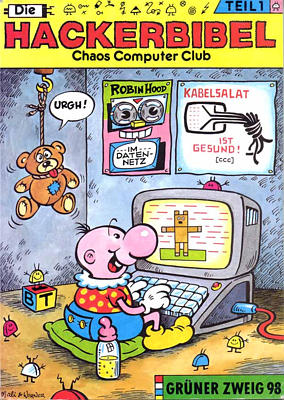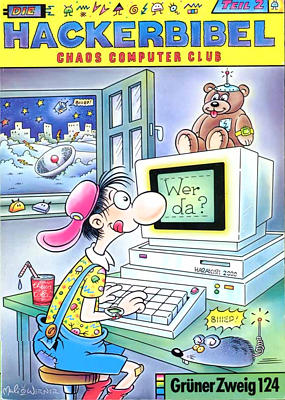George Dyson: Turing’s Cathedral: The Origins of the Digital Universe (2012)
Filed under book | Tags: · code, computing, history of computing, turing machine

“It is possible to invent a single machine which can be used to compute any computable sequence,” twenty-four-year-old Alan Turing announced in 1936. In Turing’s Cathedral, George Dyson focuses on a small group of men and women, led by John von Neumann at the Institute for Advanced Study in Princeton, New Jersey, who built one of the first computers to realize Alan Turing’s vision of a Universal Machine. Their work would break the distinction between numbers that mean things and numbers that do things—and our universe would never be the same.
Using five kilobytes of memory (the amount allocated to displaying the cursor on a computer desktop of today), they achieved unprecedented success in both weather prediction and nuclear weapons design, while tackling, in their spare time, problems ranging from the evolution of viruses to the evolution of stars.
Dyson’s account, both historic and prophetic, sheds important new light on how the digital universe exploded in the aftermath of World War II. The proliferation of both codes and machines was paralleled by two historic developments: the decoding of self-replicating sequences in biology and the invention of the hydrogen bomb. It’s no coincidence that the most destructive and the most constructive of human inventions appeared at exactly the same time.
How did code take over the world? In retracing how Alan Turing’s one-dimensional model became John von Neumann’s two-dimensional implementation, Turing’s Cathedral offers a series of provocative suggestions as to where the digital universe, now fully three-dimensional, may be heading next.
Publisher Knopf Doubleday Publishing Group, 2012
ISBN 0307907066, 9780307907066
432 pages
review (Edward J. Valauskas, First Monday)
review (Francis Spufford, The Guardian)
review (William Poundstone, The New York Times)
review (Robert Barry, review31)
Chaos Computer Club (ed.): Die Hackerbibel, 1-2 (1985, 1988) [German]
Filed under book | Tags: · computing, germany, hacker culture, hacking, history of computing, history of technology, internet, machine, networks, privacy, programming, radio, security, technology, telephone, video


“Die Hackerbibel ist eine Publikation des Chaos Computer Clubs. Sie ist bisher in zwei Ausgaben in den Jahren 1985 und 1988 erschienen. Beide Ausgaben wurden von Wau Holland herausgegeben und vom Verlag Grüne Kraft veröffentlicht.
Die Hackerbibel ist ein Sammelsurium aus Dokumenten und Geschichten der Hacker-Szene, wie beispielsweise die Bauanleitung für den als „Datenklo“ betitelten Akustikkoppler. Sie bietet darüber hinaus Bauanleitungen und andere technische Hintergründe. Die 1. Ausgabe erschien 1985 mit dem Untertitel Kabelsalat ist gesund, und erzielte bis Mitte 1988 eine verkaufte Auflage von 25.000 Exemplaren. Die Ausgabe 2 aus dem Jahr 1988 wird auch Das neue Testament genannt. Die Comic-Zeichnungen der Umschlagbilder sind eine Schöpfung der deutschen Comic-Zeichner Mali Beinhorn und Werner Büsch von der Comicwerkstatt Büsch-Beinhorn. Die Produktion und der Vertrieb der Hackerbibel wurde schon vor 1990 eingestellt. Seit 1999 bietet der CCC eine gescannte und im Volltext verfügbare Version mit weiterem Material, wie Texte von Peter Glaser, eine Dokumentation zu Karl Koch und die Arbeiten von Tron, auf der Chaos-CD an.” (wikipedia)
Die Hackerbibel Teil 1. Kabelsalat ist gesund, Grünen Kraft, Löhrbach, ISBN 3922708986, 260 Seiten
Die Hackerbibel Teil 2. Das neue Testament, Grünen Kraft, Löhrbach, ISBN 3925817247, 260 Seiten
PDF (Teil 1, 56 MB, no OCR, updated on 2024-2-3)
HTML (Teil 1, updated on 2024-2-3)
PDF (Teil 2, 43 MB, no OCR, updated on 2024-2-3)
HTML (Teil 2, updated on 2024-2-3)
Christophe Lécuyer, David C. Brock: Makers of the Microchip: A Documentary History of Fairchild Semiconductor (2010)
Filed under book | Tags: · computing, electronics, history of computing, history of technology, photolitography, technology

In the first three and a half years of its existence, Fairchild Semiconductor developed, produced, and marketed the device that would become the fundamental building block of the digital world: the microchip. Founded in 1957 by eight former employees of the Shockley Semiconductor Laboratory, Fairchild created the model for a successful Silicon Valley start-up: intense activity with a common goal, close collaboration, and a quick path to the market (Fairchild’s first device hit the market just ten months after the company’s founding). Fairchild Semiconductor was one of the first companies financed by venture capital, and its success inspired the establishment of venture capital firms in the San Francisco Bay area. These firms would finance the explosive growth of Silicon Valley over the next several decades.
This history of the early years of Fairchild Semiconductor examines the technological, business, and social dynamics behind its innovative products. The centerpiece of the book is a collection of documents, reproduced in facsimile, including the company’s first prospectus; ideas, sketches, and plans for the company’s products; and a notebook kept by cofounder Jay Last that records problems, schedules, and tasks discussed at weekly meetings. A historical overview, interpretive essays, and an introduction to semiconductor technology in the period accompany these primary documents.
Foreword by Jay Last
Publisher MIT Press, 2010
ISBN 0262014246, 9780262014243
312 pages
PDF (updated on 2012-7-25)
Comment (1)
